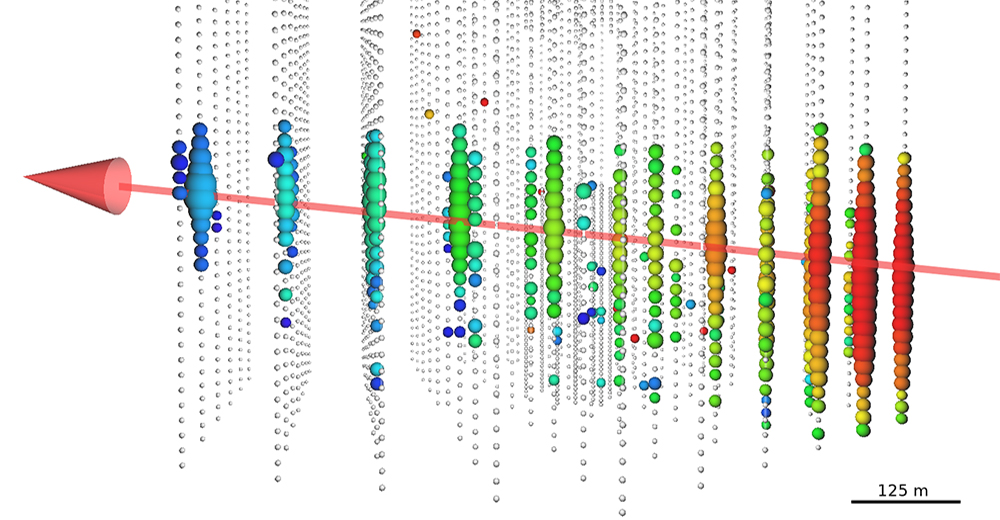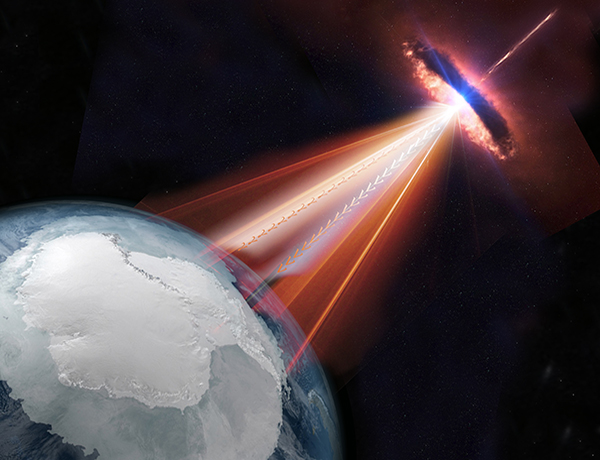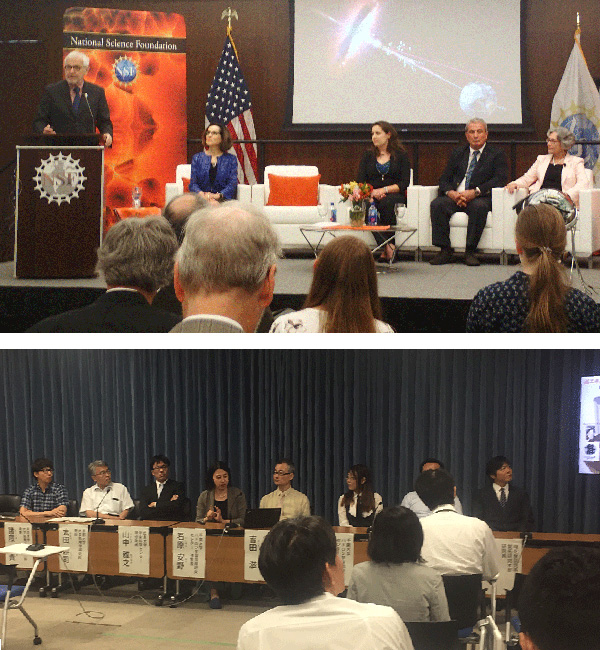Even if neutrinos are detected, an additional system to share the information promptly with the astronomers all over the world in order to observe the direction with the other electromagnetic telescopes. IceCube collaboration has developed the system (“realtime alert”) to analyze the data quickly with a good precision and to send the information to the astronomical observatories in the world, and has started to operate it since Apr 2016. The IceCube group at Chiba University was responsible for development of the Extremely High Energy (EHE) track event selection for alerts corresponding to cosmic neutrino detection sensitivity in the energy band from 100TeV to 1EeV.
Most of the neutrino events detected by IceCube are background events which are not important. The system algorithms select which events contain important information and analyze them in real-time. Then, an alert is issued to observatories around the world containing information on the event, including direction, about 30 seconds after a neutrino event is detected. Telescopes at each observatory receiving an alert are turned to look towards the origin of the neutrino and determine whether there are astronomical objects in that direction displaying any unusual activity.
Four alerts were issued over approximately one year after the first EHE neutrino event alert was sent in July 2016, but even though gamma-ray and other telescopes followed up their observations to trace back the neutrino paths, no successful identification was made.
On 23 September 2017 at 05:54 Japan Standard Time (or 22 September 2017 at 20:54 UTC), a high-energy neutrino event was identified by IceCube’s EHE track selection. It was a typical high-energy track event traveling horizontally across the IceCube detection volume and was detected under favorable conditions that allowed accurate estimation of the neutrino source direction.
 Cherenkov radiation distribution plot for IceCube 170922A. IceCube 170922A’s name comes from the fact the cosmic neutrino event was detected on 22 September 2017 UTC.
Cherenkov radiation distribution plot for IceCube 170922A. IceCube 170922A’s name comes from the fact the cosmic neutrino event was detected on 22 September 2017 UTC.Direction of travel and other observational data on IC170922A was delivered by alert to observatories around the world and tracking of the potential source began.
 Tracking observations conducted by observatories around the world based on IC170922A data. ©IceCube Collaboration
Tracking observations conducted by observatories around the world based on IC170922A data. ©IceCube Collaboration
Hiroshima University’s KANATA Telescope received the alert and began observations 20 hours after the neutrino event was detected and discovered that the blazar TXS0506+056 – which is found in the direction of the neutrino’s path – was brighter in the visible light region. Based on that discovery, Hiroshima University researchers working with the Fermi Gamma-ray Space Telescope began analyzing observational data from the Fermi LAT collaboration and found that the object was emitting gamma rays at a much higher intensity than normal.
TXS0506+056 is a known blazar (of the BL-Lac type) with a massive black hole at its core, and it was already listed in the Fermi LAT Source Catalogue. The blazar had been active since April 2017 and was emitting gamma rays at roughly six times its normal intensity. The IC170922A neutrino event was detected during that period of active gamma-ray emission.
 The blazar TXS0505+056 has a massive black hole at its core from which it emits jets of particles, and it can be found in the sky near the constellation of Orion. ©IceCube/NASA
The blazar TXS0505+056 has a massive black hole at its core from which it emits jets of particles, and it can be found in the sky near the constellation of Orion. ©IceCube/NASA
Another system of telescopes called MAGIC, or the Major Atmospheric Gamma Imaging Cherenkov Telescopes, is sensitive to higher-energy gamma rays, and it detected gamma rays with very high energies exceeding 100 GeV from this object. This was the first time that very-high-energy gamma rays were observed in the same period and same direction as a high-energy neutrino event detected by IceCube.
Subsequently, tests were conducted to ensure that IceCube’s neutrino observation and the increased brightness of the gamma rays were not simply a coincidence. Testing showed that the result was significant by 4σ. That means that the chance the two events were unrelated coincidences was only 0.003%. In addition, researchers reviewed past IceCube data and subjected the data from that direction to a more rigorous analysis and confirmed that a large number of neutrino events from the direction of the same object were detected during a 160-day period around 16 December 2014. This confirmation meant that it could be proved that this was the first time in history that researchers had identified a source of neutrino radiation.
The results were published in the US journal Science in the two following articles.
Journal:Science
Title of Paper:Multimessenger observations of a flaring blazar coincident with high-energy neutrino IceCube-170922A
Author(s):The IceCube, Fermi-LAT, MAGIC, Kanata, Kiso teams et al.
DOI:10.1126/science.aat1378
Journal:Science
Title of Paper:Neutrino emission from the direction of the blazar TXS 0506+056 prior to the IceCube-170922A alert
Author(s):IceCube Collaboration
DOI:10.1126/science.aat2890
This research served as a major step forward in understanding the still unresolved mysteries surrounding the mechanism behind extremely high energy cosmic rays, and it attracted attention from around the world. It was selected as one of the top ten breakthroughs of the year in 2018 by Science magazine.

The world’s first detection of a neutrino source showed the effectiveness of IceCube’s Realtime Alert System and the techniques of multi-messenger astronomy.
In the future, we aim to fortify this system of observation, engage in even closer cooperation with observatories around the world, and identify even more such astronomical objects. In addition, it is essential to increase neutrino sensitivity of our detectors – as neutrinos are the source of our tracking observation information – and to increase the number of event detections. Using IceCube Upgrade (scheduled to start in 2022) and the later IceCube-Gen2 programs, we will increase our detection volume to roughly eight times that of the current IceCube array in order to detect more neutrino events, enabling us to identify even more astronomical sources of neutrino emission.